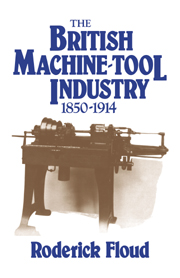Book contents
- Frontmatter
- Contents
- List of tables, figures and appendices
- Preface
- Introduction
- 1 The engineering industries
- 2 The technical history of machine tools, 1850–1914
- 3 The machine tool industry: structure and explanation
- 4 International trade in machine tools
- 5 Greenwood and Batley: history, records and methods
- 6 Greenwood and Batley: markets and prices
- 7 Greenwood and Batley: production
- Conclusion
- List of works cited
- Notes
- Index
2 - The technical history of machine tools, 1850–1914
Published online by Cambridge University Press: 02 December 2009
- Frontmatter
- Contents
- List of tables, figures and appendices
- Preface
- Introduction
- 1 The engineering industries
- 2 The technical history of machine tools, 1850–1914
- 3 The machine tool industry: structure and explanation
- 4 International trade in machine tools
- 5 Greenwood and Batley: history, records and methods
- 6 Greenwood and Batley: markets and prices
- 7 Greenwood and Batley: production
- Conclusion
- List of works cited
- Notes
- Index
Summary
The increasing specialisation and differentiation of the engineering industry was a response to the development of many new products and techniques of manufacture in the second half of the nineteenth century. The development, for example, of the electrical industries, of cycles, typewriters, sewing machines, automobiles and boot and shoe machinery, of improved steels and alloys, and of methods of power transmission and generation, all called forth new manufacturing industries and techniques. For the machine tool industry, which was the primary supplier of machinery for these new industries, these developments implied the need for constant change in its products, and a constant readiness to respond to new opportunities and new needs. Machine tools in this period were changed, and new machine tools invented, in response to two sets of pressures; firstly, manufacturers required new tools, and modifications to old tools, to carry out new processes and to make old processes more efficient. Secondly, machine tool makers produced new tools, and modified old tools, to take advantage of developments in power generation and in metals technology. Both these sets of pressures, and the responses by machine tool makers to them, were continuous, and it is important to see the development of machine tool technology in this period as a process of constant accretion to knowledge, not as a series of discrete inventions.
This point is emphasised by the proliferation of different types of machine tools which took place after 1850.
- Type
- Chapter
- Information
- The British Machine Tool Industry, 1850–1914 , pp. 20 - 31Publisher: Cambridge University PressPrint publication year: 1976



